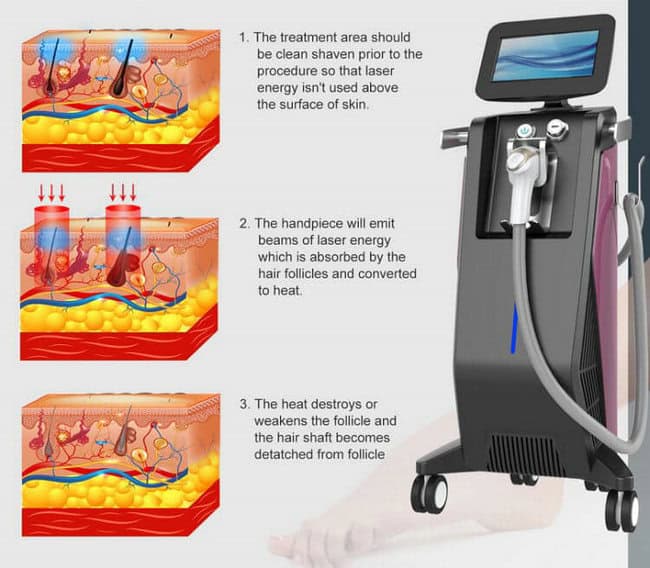Key Takeaways
Here is a summary of key differences between diode and Nd:YAG lasers for hair removal:
- Mechanism of action:
- Diode laser destroys hair follicles by targeting melanin pigment in the hair shaft. This makes it very effective for coarse, dark hair.
- Nd:YAG laser penetrates hair follicles through the skin cells rather than targeting melanin directly. This allows it to work on fine hair that has less melanin.
- Effectiveness:
- Diode laser is more effective at removing coarse, dark hair and has a shorter recovery time.
- Nd:YAG laser is better at treating fine hair but less effective at coarse hair. Older Nd:YAG machines struggle with fine hair.
- Treatment comfort/side effects:
- Diode laser has higher risk of side effects and discomfort, especially in darker skin, though new machines have improved this.
- Nd:YAG laser is considered the safest option even for darker skin. It causes less pain/discomfort.
- Treatment areas:
- Diode laser works well for small treatment areas.
- Nd:YAG laser can cover larger areas more efficiently.
In summary, the diode laser is more effective at removing dark, coarse hairs while the Nd:YAG laser has some advantages in safety and treating finer hair or larger areas. But modern machines can combine both laser types to optimize hair removal.

Overview of Diode and Nd Lasers
When looking into laser systems, you might come across two popular types: diode lasers and Nd lasers. Diode lasers utilize laser diodes as their active medium, while Nd lasers (Neodymium-doped Yttrium Aluminum Garnet) are a type of optically pumped solid-state laser. Both have unique characteristics and applications in various fields, so let’s explore their properties and benefits.
Diode lasers are known for their efficiency, compactness, and reliability. These lasers produce a high output power in the infrared spectrum and are widely used in laser hair removal, medical treatments, and telecommunications. Diode laser systems target melanin within hair follicles, making them an effective solution for coarse hair treatment and requiring shorter recovery time compared to other laser technologies.
On the other hand, Nd lasers possess an active medium made of neodymium-doped yttrium aluminum garnet crystal. Emitting a monochromatic light at 1064 nm, these lasers are particularly beneficial in medical procedures, dentistry, and scientific research. Nd lasers can be operated in continuous wave (CW) mode or Q-switched, producing high-intensity and short-duration pulses.
Frequency doubling of Nd lasers yields a 532 nm green light, which can be used for laser therapy and treating retinopathy of prematurity (ROP). Meanwhile, another variation of YAG lasers, the Er laser, operates at a different wavelength (2.94 µm) suitable for various ablative and non-ablative medical applications.
In laser hair removal, studies have shown maximum hair reduction percentages of 64% with diode lasers and 62% with Nd lasers, indicating the effectiveness of both laser types.
Technical Aspects of Diode and Nd Lasers
When considering the use of diode and Nd lasers, it’s important to understand their technical aspects to determine which type of laser is most suitable for your specific needs.
Diode Lasers: These lasers utilize semiconductor technology with laser diodes serving as the active medium. They typically emit wavelengths in the range of 800 to 980 nm. Diode lasers are optically pumped, meaning they rely on external light to excite the electrons within the laser medium. This external pump source helps to produce high output powers with minimal thermal side effects. Diode lasers tend to have longer pulse durations, which can increase the heat generated during the process. However, they also offer more precise control over pulse duration and energy compared to other laser types.
Nd Lasers: These solid-state lasers employ a crystal made from neodymium-doped yttrium aluminum garnet (Nd) as their active medium. These lasers can also produce shorter pulse durations, such as picosecond pulses, leading to high peak power output. Nd lasers are optically pumped as well, but their pump source usually consists of a flashlamp or laser diode.
In terms of laser energy, both diode and Nd lasers can generate high fluence, enabling them to deliver significant energy to the target area. However, the Nd laser may generate less heat than diode lasers due to its longer wavelength and shorter pulse duration.
When using either diode or Nd lasers, it’s important to consider factors such as wavelength, pulse duration, laser energy, and overall efficiency in relation to your specific requirements. By understanding the technical aspects of these lasers, you can make a more informed decision on which type will best serve your needs.
Diode Vs. YAG Laser Hair Removal

In the field of treatment, both Diode and Nd lasers play significant roles. One of the most common applications is laser for hair removal. When you opt for hair removal,
How Does Laser Hair Removal Work?
During a laser hair removal session, a laser emits light that penetrates your skin and gets absorbed by the melanin present in your hair follicles. The light energy converts to heat, damaging the hair follicles and inhibiting future hair growth. This process targets multiple hair follicles at once, resulting in a more efficient and quick hair removal process.
What is YAG Laser Hair Removal?
Nd laser hair removal uses a crystal of yttrium and aluminum doped with Neodymium atoms to emit monochromatic light radiation at a 1064 nm wavelength, allowing it to penetrate deep into the skin. This deep penetration feature and its selective targeting of melanin make it ideal for darker skin tones (Skin types IV-VI). Traditional lasers may struggle with these skin types and pose risks of post-treatment blistering and pigment changes, which the Nd laser effectively minimizes. Thus, Nd YAG laser hair removal has emerged as the gold standard for individuals with darker skin aiming for hair removal. Additionally, its longer wavelengths effectively target coarse hair and wider body treatment areas.
What is Diode Laser Hair Removal?
Diode laser hair removal uses a semiconductor laser to produce light at a specific wavelength. This light penetrates and is absorbed by the melanin in the hair follicle, causing sufficient thermal damage to disable future hair growth. Diode laser systems employ a wavelength of 800-810 nm, making them ideal for lighter to medium skin tones. This method effectively targets the hair follicle and melanin in the hair shaft, providing efficient and permanent hair reduction. Despite being safe for most skin types and hair colors, it may not be ideal for darker skin tones due to the risk of burning or pigmentary changes. Furthermore, systems with shorter pulse durations enable faster treatments and quicker recovery times, making them preferable for treating larger areas.
Comparing Diode and YAG Laser Hair Removal
When comparing diode and YAG laser hair removal, consider the following factors:
- Skin Tones: Both diode and YAG laser hair removal technologies are safe for various skin types. However, Nd laser is usually preferred for darker skin types (IV, V, and VI) to minimize the risk of pigmentation changes and discoloration.
- Hair Types: YAG lasers are more effective on coarse hair, while diode lasers work well on most hair types.
- Treatment Areas: The longer wavelengths of Nd make it suitable for broader treatment areas, while Diode lasers can treat larger areas with shorter recovery times due to their shorter pulse duration.
- Selective Photothermolysis: Both Nd and diode laser hair removal technologies rely on the principle of selective photothermolysis, which selectively targets melanin in the hair follicle, minimizing damage to the surrounding skin.
While there are advantages to both diode and Nd laser hair removal methods, it is essential to consider your skin tone, hair type, and treatment goals when choosing the best option for you. Always consult with a qualified professional to determine the most suitable treatment for your needs.
Gold Standard 808 Laser Hair Removal Diode Machine
Our Gold Standard 808 laser hair removal diode machine is optimal for those looking to offer superior and efficient hair removal services.

This advanced machine delivers impressive outcomes with unmatched efficiency and safety, making it a prime selection for professionals in beauty and personal care. The benefits of using Gold Standard 808 are numerous, including:
- Deep, painless penetration
- Long-lasting hair removal
- Regrowth of finer, smoother hair over time
- Suitable for hair removal from all parts of the body, including underarms, legs, chin, back, face, chest, bikini line, etc.
The laser hair removal device operates by emitting light that is absorbed by the hair’s melanin pigment. This light is transformed into heat, which targets the hair follicles to remove hair and reduce its growth, leaving the skin area smooth for a period ranging from 3 months up to a year.
Frequently Asked Questions
How do diode and Nd lasers compare with Alexandrite and IPL?
Diode, Nd, Alexandrite, and Intense Pulsed Light (IPL) are all commonly used for hair removal treatments. Diode lasers offer better melanin targeting for lighter skin tones, while Nd lasers penetrate deeper, making them more suited for darker skin tones. Alexandrite lasers are generally effective on a wider range of skin tones, but they may not be as effective on very dark skin. IPL uses a broad spectrum of light and therefore has less specificity, making it less effective on certain hair colors and skin tones, but can still be useful for some individuals.
What are the typical number of sessions required for diode laser hair removal?
The typical number of sessions required for diode laser hair removal varies depending on factors such as hair color, skin tone, and coarseness of the hair. On average, most individuals require 6 to 10 sessions for optimal results, with sessions spaced 4 to 6 weeks apart. It is essential to consult with a professional to determine the appropriate number of sessions for your specific situation, as treatment needs vary from person to person.

